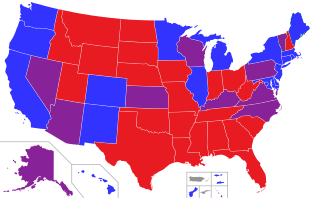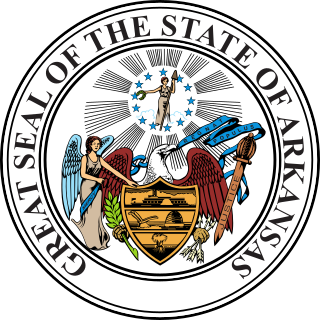
The Annotated Code of Maryland, published by The Michie Company, is the official codification of the statutory laws of Maryland. It is organized into 36 named articles. The previous code, organized into numbered articles, has been repealed. [1]

The Annotated Code of Maryland, published by The Michie Company, is the official codification of the statutory laws of Maryland. It is organized into 36 named articles. The previous code, organized into numbered articles, has been repealed. [1]

The Annotated Code of Maryland is amended through the legislative process involving both bodies of the Maryland General Assembly, the House of Delegates and the Senate. A bill is a proposal to change, repeal, or add to existing state law. A House Bill (HB) is one introduced in the House of Delegates (for example: HB 6); [2] a Senate Bill (SB), in the Senate.
Bills are designated by number, in the order of introduction in each house. For example, HB 16 refers to the sixteenth bill introduced in the House of Delegates. The numbering starts afresh each legislative session. The names of the legislator who introduced the bill and of any sponsors becomes part of the bill title. Bills listed as "The Speaker (By Request of Administration)", "The President (By Request of Administration)", "Minority Leader (By Request of Administration)", or "Committee Chair (By Request of Department)" are bills proposed by the Governor and state agencies and are not proposals of the Speaker of the House, the President of the Senate, the Minority Leader, or the respective Committee Chair. They are listed with the official title of a legislator rather than the Governor due to requirements in the Maryland Constitution. [3]
The legislative procedure, is divided into distinct stages:
The Maryland General Assembly gradually recodified the state laws by repealing the versions organized into numbered articles in the black volumes and re-enacting new versions, which were organized into named articles and published in the red volumes. For example, Chapter 26 of the 2002 Laws of Maryland recodified most of Article 27 into the Criminal Law Article. According to the Maryland State Department of Legislative Services, the state legislature committed to the recodification process in 1970. The revised articles were enacted in stages between 1973 and 2016; the 36th and last revised article to be enacted was the Alcoholic Beverages Article in 2016. [5] [1] The purpose of this process was to reorganize the laws, rather than to change their content or meaning. [6] Until the process was completed, the laws of the state of Maryland comprised both sets of volumes.
The following is a list of the 36 named articles of the code, with the year of enactment of each. Multiple entries mean that an article was enacted in stages. [1]
The last numbered article was 2B Alcoholic Beverages, which was replaced with the corresponding named article in 2016. [1]
The following is a list of some of the numbered articles, which were parts of the code before being reenacted and recodified into the named articles:

In the United States, the state legislature is the legislative branch in each of the 50 U.S. states.
An act of parliament, as a form of primary legislation, is a text of law passed by the legislative body of a jurisdiction. In most countries with a parliamentary system of government, acts of parliament begin as a bill, which the legislature votes on. Depending on the structure of government, this text may then be subject to assent or approval from the executive branch.

The California State Legislature is a bicameral state legislature consisting of a lower house, the California State Assembly, with 80 members; and an upper house, the California State Senate, with 40 members. Both houses of the Legislature convene at the California State Capitol in Sacramento. The California state legislature is one of just ten full-time state legislatures in the United States. The houses are distinguished by the colors of the carpet and trim of each house. The Senate is distinguished by the color red and the Assembly by the color green, inspired by the United Kingdom's House of Lords and House of Commons respectively.

The Alaska Legislature is the state legislature of the U.S. state of Alaska. It is a bicameral institution consisting of the 40-member Alaska House of Representatives and the 20-member Alaska Senate. There are 40 House Districts (1–40) and 20 Senate Districts (A–T). With a total of 60 lawmakers, the Alaska Legislature is the smallest bicameral state legislature in the United States and the second-smallest of all state legislatures. There are no term limits for either chamber. The Alaska Legislature meets in the Alaska State Capitol in Juneau. The current meeting since 2023 is the 33rd Alaska State Legislature. The previous meeting, the 32nd Alaska State Legislature, met from 2021 to 2023.

The Massachusetts General Court, formally the General Court of Massachusetts, is the state legislature of the Commonwealth of Massachusetts located in the state capital of Boston. The name "General Court" is a holdover from the earliest days of the Massachusetts Bay Colony, when the colonial assembly, in addition to making laws, sat as a judicial court of appeals. Before the adoption of the state constitution in 1780, it was called the Great and General Court, but the official title was shortened by John Adams, author of the state constitution. It is a bicameral body. The upper house is the Massachusetts Senate which is composed of 40 members. The lower body, the Massachusetts House of Representatives, has 160 members; until 1978, the state house had 240 members. It meets in the Massachusetts State House on Beacon Hill in Boston.

The Maryland General Assembly is the state legislature of the U.S. state of Maryland that convenes within the State House in Annapolis. It is a bicameral body: the upper chamber, the Maryland Senate, has 47 representatives, and the lower chamber, the Maryland House of Delegates, has 141 representatives. Members of both houses serve four-year terms. Each house elects its own officers, judges the qualifications and election of its own members, establishes rules for the conduct of its business, and may punish or expel its own members.

The Florida Legislature is the legislature of the U.S. state of Florida. It is organized as a bicameral body composed of an upper chamber, the Senate, and a lower chamber, the House of Representatives. Article III, Section 1 of the Florida Constitution, adopted in 1968, defines the role of the legislature and how it is to be constituted. The legislature is composed of 160 state legislators. The primary purpose of the legislature is to enact new laws and amend or repeal existing laws. It meets in the Florida State Capitol building in Tallahassee.

The Florida House of Representatives is the lower house of the Florida Legislature, the state legislature of the U.S. state of Florida, the Florida Senate being the upper house. Article III, Section 1 of the Constitution of Florida, adopted in 1968, defines the role of the Legislature and how it is to be constituted. The House is composed of 120 members, each elected from a single-member district with a population of approximately 180,000 residents. Legislative districts are drawn on the basis of population figures, provided by the federal decennial census. Representatives' terms begin immediately upon their election.

The Tennessee General Assembly (TNGA) is the state legislature of the U.S. state of Tennessee. It is a part-time bicameral legislature consisting of a Senate and a House of Representatives. The Speaker of the Senate carries the additional title and office of Lieutenant Governor of Tennessee. In addition to passing a budget for state government plus other legislation, the General Assembly appoints three state officers specified by the state constitution. It is also the initiating body in any process to amend the state's constitution.

The Maryland Senate, sometimes referred to as the Maryland State Senate, is the upper house of the General Assembly, the state legislature of the U.S. state of Maryland. Composed of 47 senators elected from an equal number of constituent single-member districts, the Senate is responsible, along with the Maryland House of Delegates, for passage of laws in Maryland, and for confirming executive appointments made by the Governor of Maryland.

The Mississippi Legislature is the state legislature of the U.S. state of Mississippi. The bicameral Legislature is composed of the lower Mississippi House of Representatives, with 122 members, and the upper Mississippi State Senate, with 52 members. Both representatives and senators serve four-year terms without term limits. The Legislature convenes at the Mississippi State Capitol in Jackson.

The Arizona State Legislature is the state legislature of the U.S. state of Arizona. It is a bicameral legislature that consists of a lower house, the House of Representatives, and an upper house, the Senate. Composed of 90 legislators, the state legislature meets in the Capitol Complex in the state capital of Phoenix. Created by the Arizona Constitution upon statehood in 1912, the Arizona State Legislature met biennially until 1950. Today, they meet annually.

The Florida Senate is the upper house of the Florida Legislature, the state legislature of the U.S. state of Florida, the Florida House of Representatives being the lower house. Article III, Section 1 of the Constitution of Florida, adopted in 1968, defines the role of the Legislature and how it is to be constituted. The Senate is composed of 40 members, each elected from a single-member district with a population of approximately 540,000 residents. Legislative districts are drawn on the basis of population figures, provided by the federal decennial census. Senators' terms begin immediately upon their election. The Senate Chamber is located in the State Capitol building.

The government of Alabama is organized under the provisions of the 2022 Constitution of Alabama. Like other states within the United States, Alabama's government is divided into executive, judicial, and legislative branches. Also like any other state, these three branches serve a specific purpose in terms of power.

The Arkansas State Senate is the upper branch of the Arkansas General Assembly. The Senate consists of 35 members, each representing a district with about 83,000 people. Service in the state legislature is part-time, and many state senators have full-time jobs during the rest of the year. During the current term, the Senate contains twenty-nine Republicans and six Democrats.

The Alabama Legislature is the legislative branch of the government of the U.S. state of Alabama. It is a bicameral body composed of the House of Representatives and Senate. It is one of the few state legislatures in which members of both chambers serve four-year terms and in which all are elected in the same cycle. The most recent election was on November 8, 2022. The new legislature assumes office immediately following the certification of the election results by the Alabama Secretary of State which occurs within a few days following the election.

The Kansas Legislature is the state legislature of the U.S. state of Kansas. It is a bicameral assembly, composed of the lower Kansas House of Representatives, with 125 state representatives, and the upper Kansas Senate, with 40 state senators. Representatives are elected for two-year terms, senators for four-year terms.

The Kansas Senate is the upper house of the Kansas Legislature, the state legislature of the U.S. State of Kansas. It is composed of 40 senators elected from single-member districts, each with a population of about 73,000 inhabitants. Members of the Senate are elected to a four-year term. There is no limit to the number of terms that a senator may serve. The Kansas Senate meets at the Kansas State Capitol in Topeka.
Ryan's Law is a South Carolina law which requires insurance companies to cover treatments for autism. The law states that insurance companies must provide up to $50,000, annually, on behavioral therapy, up to the age of 16. The law provides coverage for various treatments, including Applied Behavior Analysis, which was previously denied as "experimental". Ryan's Law also prohibits insurers from refusing other medical care to children because of their autism. The law does not apply to people who are self-insured.

Mike Griffith is a Republican member of the Maryland House of Delegates representing District 35B since January 7, 2020. Griffith was appointed by Maryland governor Larry Hogan after Andrew Cassilly resigned the seat to become a senior advisor to Hogan.
{{cite journal}}: Cite journal requires |journal= (help)